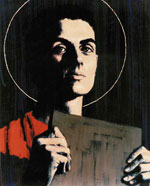 Saint Viator was both a lector of the Church of Lyons, France, and a disciple and companion of Bishop Just. He was probably born in Lyons during the 4th Century in a Roman or Gallo-Roman family. After finishing his studies as a youth, he probably entered the local cathedral school for lectors as an adult where he would have studied the Scriptures, the writings of the Church Fathers, and the art of correctly reading and proclaiming the Scriptures at liturgy.
Saint Viator was both a lector of the Church of Lyons, France, and a disciple and companion of Bishop Just. He was probably born in Lyons during the 4th Century in a Roman or Gallo-Roman family. After finishing his studies as a youth, he probably entered the local cathedral school for lectors as an adult where he would have studied the Scriptures, the writings of the Church Fathers, and the art of correctly reading and proclaiming the Scriptures at liturgy.
After he and his classmates completed their training, the bishop would have ordained the men to the order of lector at a special ceremony that included special prayers for the young candidates, presentation of the lectionary containing the Scriptures that were used at liturgy, and a commission to proclaim the Scriptures.
In the 4th Century, the order of lector was deemed permanent and the requirements included the continual nurturing of an ever-deeper faith life and performing the apostolic works of reverently proclaiming the Scriptures at liturgy and the teaching of Christian doctrine to the young people.
The life and work of St. Viator was inextricably bound with the life of his Bishop, St. Just. Sometime after 343, Just was chosen as bishop of Lyons, his contemporaries describing him as a meek and merciful man of great learning.
After 30 years as bishop, he decided that he wanted to resign his bishopric so as to live out his days in solitude as a monk in the Egyptian desert, a decision he shared with Saint Viator. While deliberating this decision, a tragic event occurred in Lyons.
A mad man raced through the market place of the city, slashing wildly with a sword, and wounding and killing many citizens. He then dashed to the cathedral and claimed the right of sanctuary. A mob gathered to storm the church, and Bishop Just intervened. He halted the mob, but under pressure of their violence he agreed to hand the man over to the magistrates for a fair trial. No sooner had this been done, than the mob seized the man from the magistrate’s guard, and killed him on the spot. The bishop came to believe that his failure to adequately protect the murderer had soiled him with the poor man’s blood, and therefore, he was unworthy to continue to lead the Christian community, and that his failure required him to devote the remainder of his life to doing penance.
It would seem that before the year 381 was out, Bishop Just secretly left Lyons for Marseilles, where he would take ship to Alexandria in Egypt. Viator, knowing his intentions, decided to follow his bishop and master. He caught up with the bishop at Marseilles, and together they boarded ship for Egypt.
Once in Egypt, they joined the community of monks in the desert of Scete in the Libyan Desert, about 40 or 50 miles south of Alexandria. The monastery had a reputation for demanding great holiness and a fierce asceticism from its members. Most of the monks lived in cells, either dug in the ground, or built of stones, each out of sight of the others. They came together only on Saturdays and Sundays to celebrate the liturgy. They supported themselves by manual labor, and ate only the poorest of foods. Fasting, prayer, silence, and the keeping of night vigils, characterized their lives.
While there it seems that Bishop Just and his Lector Viator did not reveal their identities to the community they had joined in Egypt. Yet, by chance, several years after their arrival, a pilgrim from Lyons recognized them, and urged them to return with him. They refused. Apparently, on his return to Lyons, the pilgrim informed the Church there, for shortly afterwards, a priest of Lyons, Antiochus, who later was to become the bishop of Lyons, was sent to persuade the two men to return and take up their lives again in Lyons. His efforts failed.
Tradition has it that Bishop Just died soon after the visit of Antiochus, probably around the year 390, and that Viator died shortly thereafter. The cause of these deaths is unknown. Perhaps, in the case of Bishop Just, it was simply old age. Viator’s death so soon after that of his bishop and friend suggests that weakened by grief and the rigors of life in the desert, he could have become a victim of disease, which periodically reached epidemic proportions in monastic communities.
When news of these deaths reached Lyons, arrangements were made to bring the bodies of these two saintly men back to Lyons. At that time, the monastic life was venerated as a form of martyrdom, and the earthly remains of holy monks were honored as much as those of the martyrs. The bodies of Just and Viator were returned to Lyons sometime before the end of the century, probably 399.
Well-founded tradition reported that the bodies of the two saints arrived in the city on Aug. 4 and on Sept. 2 were placed in the Church of the Maccabees, to which title, the name of St. Just would soon be added.
The cult of Saints Just and Viator soon became very popular and by the 5th Century there were four feast days celebrating their lives: Aug. 4 marked the arrival of the relics in Lyons; Sept. 2 was the celebration of the transfer of the relics to the Church of the Maccabees; Oct. 14 marked the departure of the two saints for Egypt; and Oct. 21 was a particular feast of St. Viator, which is continues to this day.
As the centuries progressed into the Middle Ages, the veneration of them continued to grow and in the 13th Century their relics were placed in richly ornamented chests and buried in a new crypt. However, in the modern era two revolutions had significant consequences. During the Reformation, a group of Calvinists attacked Lyons in 1562 and destroyed the church. During the French Revolution, a local mob desecrated the church in 1793.
In 1830, Fr. Louis Joseph Marie Querbes, a priest of the diocese of Lyons, established a society of catechists, which he placed under the patronage of St. Viator. Louis Querbes, born in 1793, was reared and educated in the parish of St. Nizier, the church built on the site of the ancient Church of the Holy Apostles, the cathedral where Just presided as bishop, and Viator served as lector. After attending the clerical school at St. Nizier, the young Querbes entered the seminary. After his ordination in 1817, he returned to his home parish where he served as an associate pastor and teacher in the school. In 1822 he was appointed pastor of the Church of St. Bonnet, in Vourles, a nearby village. It was there that his association was established, an association which by the year 1838 had become a religious congregation of priests and brothers, papally approved, as the Congregation of the Parochial Clerics or Catechists of Saint Viator.
